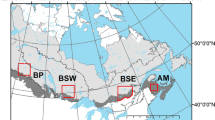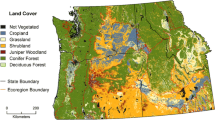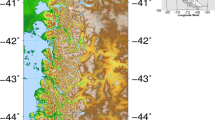Abstract
Upland forests in the Pacific Northwest currently provide a host of ecosystem services. However, the regional climate is expected to warm significantly over the course of the 21st century and this factor must be accounted for in planning efforts to maintain those services. Here we couple a dynamic global vegetation model (MC2) with a landscape simulation model (Envision) to evaluate potential impacts of climate change on the vegetation cover and the disturbance regime in the Willamette River Basin, Oregon. Three CMIP5 climate model scenarios, downscaled to a 4 km spatial resolution, were employed. In our simulations, the dominant potential vegetation cover type remained forest throughout the basin, but forest type transitioned from primarily evergreen needleleaf to a mixture of broadleaf and needleleaf growth forms adapted to a warmer climate. By 2100, there was a difference (i.e., climate/vegetation disequilibrium) between potential and actual forest type for 20–50 % of the forested area. In the moderate to high climate change scenarios, the average area burned per year increased three to nine fold from the present day. Forest harvest on private land is projected to be affected late in the century because of fire altering the availability of rotation-age stands. A generally more disturbed and open forest landscape is expected, which may significantly alter the hydrologic cycle.





Similar content being viewed by others
References
Abatzoglou JT, Brown TJ (2011) A comparison of statistical downscaling methods suited for wildfire applications. Int J Climatol 32:772–780
Abatzoglou JT, Kolden CA (2013) Relationships between climate and macroscale area burned in the Western United States. Int J Wildland Fire 22:1003–1020
Aitken SN, Yeaman S, Holliday JA, Wang TL, Curtis-McLane S (2008) Adaptation, migration or extirpation: climate change outcomes for tree populations. Evol Appl 1:95–111
Allen CD et al (2010) A global overview of drought and heat-induced tree mortality reveals emerging climate change risks for forests. For Ecol Manag 259:660–684
Bolte JP, Hulse DW, Gregory SV, Smith C (2007) Modeling biocomplexity—actors, landscapes and alternative futures. Environ Model Software 22:570–579
Bu R, He HS, Hu YM, Chang Y, Larsen DR (2008) Using the LANDIS model to evaluate forest harvesting and planting strategies under possible warming climates in Northeastern China. For Ecol Manag 254:407–419
Busing RT, Solomon AM, McKane RB, Burdick CA (2007) Forest dynamics in Oregon landscapes: evaluation and application of an individual-based model. Ecol Appl 17:1967–1981
Chen PY, Welsh C, Hamann A (2010) Geographic variation in growth response of Douglas-fir to interannual climate variability and projected climate change. Glob Chang Biol 16:3374–3385
Coops NC, Waring RH (2011) Estimating the vulnerability of fifteen tree species under changing climate in Northwest North America. Ecol Model 222:2119–2129
Daly C et al (2008) Physiographically sensitive mapping of climatological temperature and precipitation across the conterminous United States. Int J Climatol 28:2031–2064
Davis MB (1989) Lags in vegetation response to greenhouse warming. Clim Change 15:75–82
Dennison PE, Brewer SC, Arnold JD, Moritz MA (2014) Large wildfire trends in the western United States, 1984–2011. Geophys Res Lett 41:2928–2933
Emmingham WH (2002) Status of uneven-aged management in the Pacific Northwest, USA. Forestry 75:433–436
Envision (2014) http://envision.bioe.orst.edu/
Fowells HA (1965) Silvics of Forest Trees of the United States, U.S.D.A. Forest Service, Agricultural Handbook 271
GAP (2014) US Geological Survey, Gap Analysis Program (GAP). National Land Cover, Version 2. http://gapanalysis.usgs.gov/gaplandcover/data/
Garman SL, Swanson FJ, Spies TA (1999) Past, present, future landscape patterns in the Douglas-fir region of the Pacific Northwest. In: Rochelle JA, Lehmann LA, Wisniewski J (eds) Forest fragmentation: wildlife and management implications. Brill Academic Publishing, The Netherlands, pp 61–86
Gedalof Z, Peterson DL, Mantua NJ (2005) Atmospheric, climatic, and ecological controls on extreme wildfire years in the Northwestern United States. Ecol Appl 15:154–174
Halofsky JE, Hemstrom MA, Conklin DR, Halofsky JS, Kerns BK, Bachelet D (2013) Assessing potential climate change effects on vegetation using a linked model approach. Ecol Model 266:131–143
Halofsky JE, Creutzburg MK, Hemstrom MA (2014) Integrating social, economic, and ecological values across large landscapes, General Technical Report PNW-GTR-896. U.S.D.A. Pacific Northwest Research Station
He HS, Keane RE, Iverson LR (2008) Forest landscape models, a tool for understanding the effect of the large-scale and long-term landscape processes. For Ecol Manag 254:371–374
Healey SP, Cohen WB, Spies TA, Moeur M, Pflugmacher D, Whitley MG, Lefsky M (2008) The relative impact of harvest and fire upon landscape-level dynamics of older forests: lessons from the Northwest forest plan. Ecosystems 11:1106–1119
Hostetler SW, Bartlein PJ, Solomon AM, Holman JO, Busing RT, Shafer SL (2005) Climatic controls of fire in the Western United States: from the atmosphere to ecosystems, Joint Fire Sciences Program (01-1-6-05)
ILAP (2013) Integrated Landscape Assessment Project. http://oregonstateedu/inr/ilap
ILAP_STMs (2014) ILAP State and Transition Models. R6_PVT-Models_20120701.mdb at ftp://131.252.97.79/ILAP/Modeling/Documents/
IPCC (2014) Intergovernmental Panel on Climate Change. Fifth Assessment Report, http://www.ipcc.ch/
Keane RE, Holsinger LM, Parsons RA, Gray K (2008) Climate change effects on historical range and variability of two large landscapes in Western Montana, USA. For Ecol Manag 254:375–389
Kennedy RE, Yang ZG, Cohen WB (2010) Detecting trends in forest disturbance and recovery using yearly Landsat time series: 1. LandTrendr—temporal segmentation algorithms. Remote Sens Environ 114:2897–2910
Kennedy RE, Yang ZQ, Cohen WB, Pfaff E, Braaten J, Nelson P (2012) Spatial and temporal patterns of forest disturbance and regrowth within the area of the Northwest forest plan. Remote Sens Environ 122:117–133
Knutti R, Furrer R, Tebaldi C, Cermak J, Meehl GA (2010) Challenges in combining projections from multiple climate models. J Climate 23:2739–2758
Kuchler A (1975) Potential natural vegetation of the United States. American Geographical Society, New York
Latta G, Temesgen H, Adams D, Barrett T (2010) Analysis of potential impacts of climate change on forests of the United States Pacific Northwest. For Ecol Manag 259:720–729
Law BE, Waring RH (2015) Carbon implications of current and future effects of drought, fire and management on Pacific Northwest forests. Forest Ecol Manag In Press
Lenihan JM, Bachelet D, Neilson RP, Drapek R (2008a) Response of vegetation distribution, ecosystem productivity, and fire to climate change scenarios for California. Clim Change 87:S215–S230
Lenihan JM, Bachelet D, Neilson RP, Drapek R (2008b) Simulated response of conterminous United States ecosystems to climate change at different levels of fire suppression, CO2 emission rate, and growth response to CO2. Global Planet Chang 64:16–25
Littell JS, McKenzie D, Peterson DL, Westerling AL (2009) Climate and wildfire area burned in western U. S. ecoprovinces, 1916-2003. Ecol Appl 19:1003–1021
MACA (2014) MACA data portal. http://climate.nkn.uidaho.edu/MACA/downloadTools.php
Marlon JR et al (2009) Long-term perspective on wildfires in the Western USA. Proc Natl Acad Sci USA 109:E535–E543
Mori AS, Johnson EA (2013) Assessing possible shifts in wildfire regimes under a changing climate in mountainous landscapes. For Ecol Manag 310:875–886
Nelson E et al (2009) Modeling multiple ecosystem services, biodiversity conservation, commodity production, and tradeoffs at landscape scales. Front Ecol Environ 7:4–11
Nitschke CR, Innes JL (2013) Potential effect of climate change on observed fire regimes in the Cordilleran forests of South-Central Interior, British Columbia. Clim Chang 116:579–591
OFPA (2014) Oregon Forest Practices Act, http://www.oregon.gov/ODF/privateforests/pages/fpakeys.aspx
Ohmann JL, Gregory MJ, Roberts HM, Cohen WB, Kennedy RE, Yang ZQ (2012) Mapping change of older forest with nearest-neighbor imputation and Landsat time-series. For Ecol Manag 272:13–25
Parton WJ et al (1993) Observations and modelling of biomass and soil organic matter dynamics for the grassland biome worldwide. Global Biogeochem Cycles 7:785–809
PATH (2014) The path landscape model. http://www.pathmodel.com
Peterman W, Bachelet D, Ferschweiler K, Sheehan T (2014) Soil depth affects simulated carbon and water in the MC2 dynamic global vegetation model. Ecol Model 294:84–93
Preisler HK, Hicke JA, Ager AA, Hayes JL (2012) Climate and weather influences on spatial temporal patterns of mountain pine beetle populations in Washington and Oregon. Ecology 93:2421–2434
Rehfeldt GE, Jaquish BC, Lopez-Upton J, Saenz-Romero C, St Clair JB, Leites LP, Joyce DG (2014a) Comparative genetic responses to climate for the varieties of Pinus ponderosa and Pseudotsuga menziesii: realized climate niches. For Ecol Manag 324:126–137
Rehfeldt GE, Jaquish BC, Saenz-Romero C, Joyce DG, Leites LP, St Clair JB, Lopez-Upton J (2014b) Comparative genetic responses to climate in the varieties of Pinus ponderosa and Pseudotsuga menziesii: reforestation. For Ecol Manag 324:147–157
Rogers BM, Neilson RP, Drapek R, Lenihan JM, Wells JR, Bachelet D, Law BE (2011) Impacts of climate change on fire regimes and carbon stocks of the U.S. Pacific Northwest. J Geophys Res Biogeosci 116:13
Rounsevell MDA, Robinson DT, Murray-Rust D (2012) From actors to agents in socio-ecological systems models. Philos Trans R Soc B Biol Sci 367:259–269
Rupp DE, Abatzoglou JT, Hegewisch KC, Mote PW (2013) Evaluation of CMIP5 20th century climate simulations for the Pacific Northwest USA. J Geophys Res Atmos 118:10884–10906
Shafer SL, Bartlein PJ, Thompson RS (2001) Potential changes in the distributions of western North America tree and shrub taxa under future climate scenarios. Ecosystems 4:200–215
Shifley SR, Thompson FR, Dijak WD, Fan ZF (2008) Forecasting landscape-scale, cumulative effects of forest management on vegetation and wildlife habitat: a case study of issues, limitations, and opportunities. For Ecol Manag 254:474–483
Spies TA, Giesen TW, Swanson FJ, Franklin JF, Lach D, Johnson KN (2010) Climate change adaptation strategies for federal forests of the Pacific Northwest, USA: ecological, policy, and socio-economic perspectives. Landscape Ecol 25:1185–1199
Steinman BA, Abbott MB, Mann ME, Stansell ND, Finney BP (2012) 1,500 year quantitative reconstruction of winter precipitation in the Pacific Northwest. Proc Natl Acad Sci U S A 109:11619–11623
Stephens SL, Moghaddas JJ, Edminster C, Fiedler CE, Haase S, Harrington M, Keeley JE, Knapp EE, McIver JD, Metlen K, Skinner CN, Youngblood A (2009) Fire treatment effects on vegetation structure, fuels, and potential fire severity in western US forests. Ecol Appl 19:305–320
Stephens SL, Agee JK, Fule PZ, North MP, Romme WH, Swetnam TW, Turner MG (2013) Managing forests and fire in changing climates. Science 342:41–42
Stocks BJ, Lawson BD, Alexander ME, Van Wagner CE, McAlpine RS, Lynham TJ, Dube DE (1989) The Canadian forest fire danger rating system: an overview. For Chron 65:450–457
Tepley AJ, Swanson FJ, Spies TA (2014) Post-fire tree establishment and early cohort development in conifer forests of the western Cascades of Oregon, USA. Ecosphere 5:23
Turner DP, Ritts D, Kennedy RE, Gray A, Yang Z (2015) Effects of harvest, fire, and pest/pathogen disturbances on the West Cascades ecoregion carbon balance. Carbon Balance Manag 10:12
USDA (1994) Record of decision for amendments to Forest Service and Bureau of Land Management planning documents within the range of the northern spotted owl. 74 p. (plus Attachment A: Standards and guidelines)
van Mantgem PJ et al (2009) Widespread increase of tree mortality rates in the Western United States. Science 323:521–524
Wang T, Hamann A, Yanchuk A, O’Neill GA, Aitken SN (2006) Use of response functions in selecting lodgepole pine populations for future climates. Glob Chang Biol 12:2404–2416
Waring RH, Coops NC, Mathys A, Hilder T, Latta G (2014) Process-based modeling to assess the effects of recent climatic variation on site productivity and forest function across western North America. Forests 5:518–534
Weisberg PJ (2009) Historical fire frequency on contrasting slope facets along the McKenzie River, Western Oregon Cascades. West N Am Nat 69:206–214
Weisberg PJ, Swanson FJ (2003) Regional synchroneity in fire regimes of western Oregon and Washington, USA. For Ecol Manag 172:17–28
Westerling AL, Hidalgo HG, Cayan DR, Swetnam TW (2006) Warming and earlier spring increases western U.S. forest wildfire activity. Science 313:940–943
Westerling AL, Bryant BP, Preisler HK, Holmes TP, Hidalgo HG, Das T, Shrestha SR (2011) Climate change and growth scenarios for California wildfire. Clim Chang 109:445–463
Whitlock C, Shafer SL, Marlon J (2003) The role of climate and vegetation change in shaping past and future fire regimes in the northwestern US and the implications for ecosystem management. For Ecol Manag 178:5–21
Yospin GI et al (2015) A new model to simulate climate-change impacts on forest succession for local land management. Ecol Appl 25:226–242
Acknowledgments
David Ritts (Oregon State University) developed the figures. Thanks to John Abatzoglou (University of Idaho) for producing the downscaled climate data, and David Rupp (Oregon State University) for consulting on selection of our 3 climate scenarios. Support was provided by the National Science Foundation under Grant Number EAR-1039192 to the Willamette 2100 Project.
Author information
Authors and Affiliations
Corresponding author
Electronic supplementary material
Below is the link to the electronic supplementary material.
ESM 1
(DOCX 334 kb)
Rights and permissions
About this article
Cite this article
Turner, D.P., Conklin, D.R. & Bolte, J.P. Projected climate change impacts on forest land cover and land use over the Willamette River Basin, Oregon, USA. Climatic Change 133, 335–348 (2015). https://doi.org/10.1007/s10584-015-1465-4
Received:
Accepted:
Published:
Issue Date:
DOI: https://doi.org/10.1007/s10584-015-1465-4




